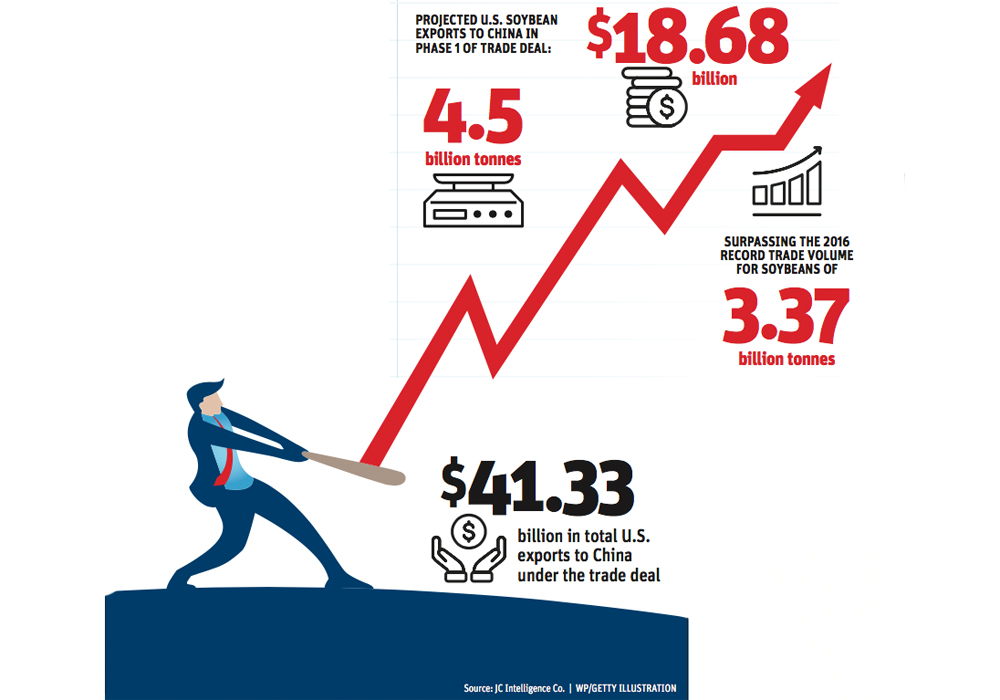Grain and oilseed markets could blow up if the United States and China sign and implement phase one of a trade deal they agreed to late last year, says an analyst.
“This would be a massive game-changer,” said Rich Nelson, chief strategist with Allendale Inc.
Few details about the two-year deal have been released other than China has agreed to buy US$40 billion to $50 billion of U.S. agricultural products per year. Signing of the deal is scheduled for Jan. 15.
Western media have been skeptical about China’s dollar commitment but China’s leading agriculture consultancy believes it is feasible.
Read Also

Farming Smarter receives financial boost from Alberta government for potato research
Farming Smarter near Lethbridge got a boost to its research equipment, thanks to the Alberta government’s increase in funding for research associations.
JC Intelligence Co. (JCI) estimated China can buy $41.3 billion of U.S. agricultural products in 2020.
“JCI strongly believes that China has the ability and will fulfil its promise,” the company said in a report.
JCI’s breakdown of the deal includes $18.7 billion or 45 million tonnes of U.S. soybean exports. The previous record high was 33.66 million tonnes in 2016.
Nelson has crunched the numbers and he agrees with JCI’s breakdown of trade volumes.
“The deal would be incredible,” he said. “The potential here is so huge.”
A soybean export program to China of that magnitude would push nearby soybean futures to $12 per bushel, up from the $9.50 the commodity was trading at on Dec. 31, 2019.
“At a minimum, we have a $2.50 rally if this is fully implemented,” said Nelson.
Of course, that is a big “if” given the rocky nature of the negotiations leading up to the announcement of a deal on Dec. 13.
“We know that China has a deep history of reneging on deals,” he said.
Nelson said he believed canola futures prices will also rally but perhaps not to the same magnitude as soybeans. He estimated they could jump by 20 percent compared to 26 percent for soybeans.
The impact on wheat prices could be “reasonably large” as well. JCI is forecasting five million tonnes of U.S. wheat imports, up from the previous high of 3.8 million tonnes in 2013.
Nelson thinks that would lead to a 40 cents per bu. rally in wheat prices. However, wheat could further benefit from a general feed grain rally led by corn.
JCI is forecasting eight million tonnes of U.S. corn exports to China in 2020, up from the previous high of 5.1 million tonnes in 2012.
Allendale believes there would also be an estimated 3.8 million tonne increase in corn destined for the U.S. feed market.
China will be consuming way more U.S. sorghum and distiller’s grains, meaning there will be a void for corn to fill in the feed market.
There could also be a moderate increase in corn ethanol production as China imports more U.S. ethanol.
Nelson said the corn price rally will be somewhat muted by a higher acreage base in 2020 but he is still forecasting a summer high of $4.40 to $4.50 for December futures, which would be about 40 to 50 cents above today’s levels.
JCI is forecasting $2.1 billion in U.S. frozen pork and offal exports to China, a little more than three times the previous high in 2011.
Nelson said it could be closer to $3.5 billion worth of product, a fivefold increase from the estimated $700 million sold in 2019.
But he isn’t as bullish on hog prices as he is for grains because the market appears to have already factored in the increased sales potential to China. The 2020 hog futures are at an $8 per hundredweight premium over 2019 futures.
“I do think there is a little more upside for the hog side but I don’t think this is going to cause the runaway rally that some are suggesting,” said Nelson.


















